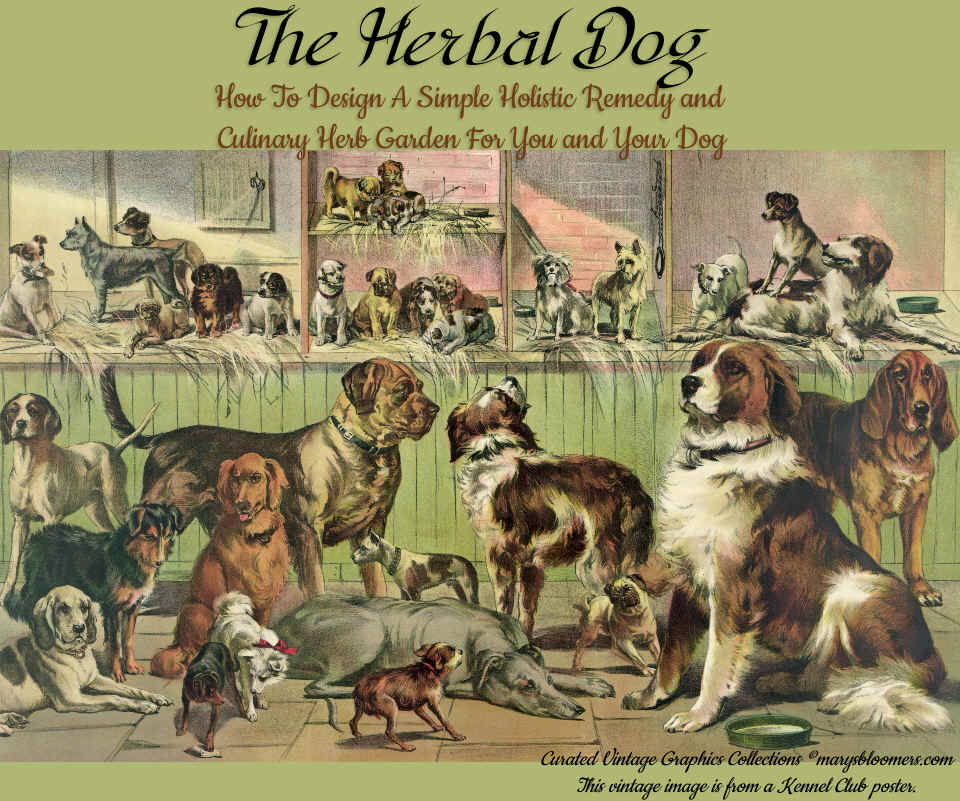|
Here is a garden plan for creating a delicious
and holistic medicinal garden for your dog that does double duty as a
medicinal and culinary garden for pet families. An ornamental garden that
contains herbs that are good for you, as well as good for your canine family member.
Herb listed are those that were deemed safe for
ingestion, but I do not suggest dosages.
The popular lists of plants toxic to dogs does not allow for low-dosage use,
which may be perfectly safe as part of their diets.
Safe herbs for one dog may not be appropriate for another.
Recipes will be posted later for treats are natural, healthy, and do not contain
toxic ingredients.
They are snacks, and not meant to be a large part of your dog's diet.
Do not feed them to animals with allergies, and consult with your vet to
ascertain what your dog may be allergic to.
A holistic vet would be the best person to guide you in holistic diets.
Information provided is sourced from holistic
veterinarian articles and statements of holistic veterinary practitioners. It is for
information only - we are not doctors or veterinarians, and we do not suggest
you treat your furry friend without a veterinarian's advice and approval. Do not
use this info to treat dogs who are pregnant or sick.
Follow a veterinarianís directions and precautions
carefully when adding herbs and spices to your dogís diet. Stop using an herb
if you notice any changes in your dogís behavior or any gastrointestinal
symptoms develop.
What To Plant
Always check the USDA Plant Hardiness Maps in choosing what to grow in your
gardens
Plants not hardy in your area will probably enjoy
spending winters indoors, in a sunny spot or under grow lights until they can
vacation outdoors again. And you will have herbs for your culinary specialties
ready to be snipped fresh when you need it. So go ahead and plant them!
It's easy to begin a design for an herbal culinary and
medicinal garden for your dog that's a treat to a dog parent's eyes and senses,
as well.
Many herbs listed are good for humans, too.
Your entire family can take advantage of these wellness-enhancing and
illness-prevention herb, seasonings and spices. The fragrances of herbs are also
beneficial in a healing, sensory or serenity garden.
Herb plants are beautiful and fragrant. Plant
some in-ground, and definitely plant some in pots and place them in several
places in your healing garden. Pots keep them looking the way you want them to,
and allows you to change up your garden design by just moving them around or
clustering. And you can grow non-hardy plants and bring them in to live on your
windowsill in winter.
My favorite types of planters in all sizes for herbs are real clay or cement
pots. Look-alikes in resin are fine, but I like the feel of natural stone and
clay. They add a rustic and natural touch. They come in all sizes, and a very
pretty type that is a shallow bowl meant for planting succulents and tiered
planters can be filled with herbs to add height to the garden. Combine shallow
and tall, short and wide, rows of small pots on sills or atop walls.... there's
no limit to your design capabilities.
Make use of elevated raised bed gardens to keep
nocturnal marauders like rabbits, raccoons and others varmints away from
the bounty.
They can be combined with the clay pots in your design, to add height and
usable space beneath.
An herbal garden is naturally filled with a lot
of shades of green. Many fruit or flower. Include perennials and dwarf shrubs
for pops of color all season that delight the eye, and provide aromatherapy.
Low-growing, ground cover herbs like lemon thyme, are meant to be stepped on to
release their fragrance along paths and between stones, as well as being a
wonderful culinary herb.
Plants listed are for both dog-friendly, and
ornamental, fragrant plants that can be just for your enjoyment, for healing and
for cooking.
Dogs might enjoy the aromatherapy from the garden, as well. Their noses are quite
sensitive to aromas. Grow this as a canine medicinal herb garden, or combine it
with your culinary and medicinal herb gardens.
All of the herbs in the article are favorites of humans for culinary and
medicinal use, and therefore, they should be planted in your herb or medicinal
garden whether you feed them to your pet or not.
If you're planning this type of garden, plant it in an area that your dog has no
access to on its own. You don't want them romping through it or grazing, and you don't want them ingesting herbs
unsupervised. The idea is what to grow in a medicinal herb garden that is good
for dogs once picked fresh or dried.
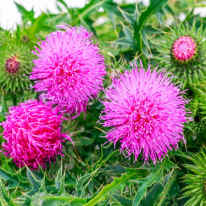 |
Milk Thistle
This is a very pretty
ornamental plant in any style of garden. Popular among holistic veterinarians, it
scavenges free radicals and can stabilize liver cell membranes, while
stimulating. Milk Thistle stimulates the production of new liver cells. It is used in both pets and humans. Extensive studies and testing
have determined that milk thistle is safe in treating liver disease and kidney
disease. It is considered safe, and has no known drug interactions.
|
|
|
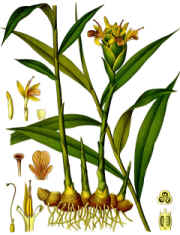 |
Ginger Root
Use caution and under the advice of a
veterinarian.
It should not be fed to a pregnant dog, or a dog with gastric problems.
Ginger should used carefully and sparingly.
This herb aids humans in nausea, gas, motion sickness, heart problems, and it
reduces joint inflammation of an arthritic dog.
My senior
dog does well with it, and enjoys a little powdered ginger sprinkled onto her food.
|
|
|
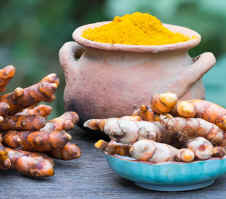 |
Turmeric
My dog just loves turmeric sprinkled onto, or
cooked into her food.
Turmeric has a peppery and bitter flavor. Turmeric rhizomes provide the main
ingredient in curry powder.
Turmeric is an anti-inflammatory, and veterinarians consider it safe for dogs.
Veterinarians recommend adding up to ľ teaspoon a day
to a dog's food.
Turmeric fights progression of arthritis, and eases pain in arthritic dogs. |
|
|
 |
Flax/Flaxseed
Another pretty, ornamental plant for the herb garden.
Ground flaxseed
has proven to work significantly in canine heart health.
I sprinkle flaxseed into my smoothies. It's a natural source
of fiber and antioxidants, and might have a positive effect on tumors. Flaxseed
is full of Omega-3 fatty acid and
B vitamins. I sprinkle the seed on my dog's food.
It's said to improve a dogís coat, and helps the digestive system. |
|
|
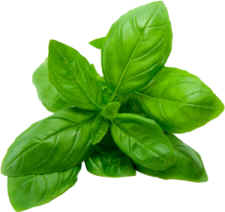 |
Basil
Basil has antioxidant, antiviral, and antimicrobial properties.
I serve it fresh or dried, cooked into my dog's homemade meals,
or just chopped and sprinkled on
her dinner. |
|
|
 |
Fennel
A digestive aid, it helps in weight control
by helping to
control the appetite.
I love it because it tastes like licorice.
Fresh "Finocchio" is commonplace on many Italian antipasto
plates, and the seed is an ingredient in sausage-making.
Its fine, ferny leaves are ornamental in the herb garden. |
|
|
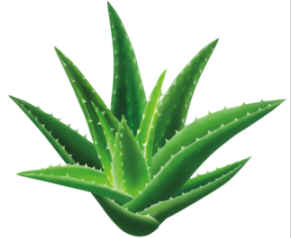 |
Aloe Vera
A natural and common additive in dog treats, foods and other pet
products.
Aloe Vera contains amino acids, iron,
phosphorus, potassium, zinc, magnesium. Commonly used as an
anti-inflammatory, for burn- and wound-healing. It's been deemed a safe
and very effective healing herb and antioxidant for humans and canines. |
|
|
|
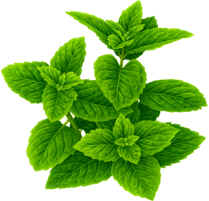
|
Peppermint
Peppermint, when used along with
ginger, helps to relieve motion sickness in pets.
Peppermint has a soothing effect on an
upset stomach. It works on respiratory infection, viral infection, skin
conditions, relieves flatulence and indigestions. Peppermint can
provide relief of several digestive ailments, including nausea
and indigestion.
It is a well-known and often-used ingredient in herbal teas and
cocktails. So grow some for you. There are several types of mint - grow
peppermint for your medicinal herb use. It's perennial and invasive, as
all mints are, so grow in a confined area or in pots. They love a sunny
windowsill, so you can bring some in for the winter and pinch it when
needed. |
|
|
|
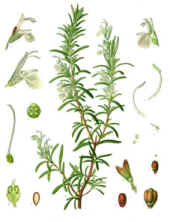
|
Rosemary
An evergreen, fragrant and
perennial herb that is a human culinary favorite.
High in fiber and loaded with vitamins and antioxidants. Rosemary is
also an anti-inflammatory, and anti-fungal.
|
|
|
|
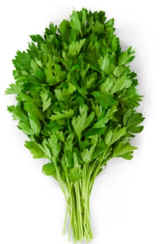
|
Parsley
Whether curly leaf or flat leaf parsley, it is a popular and common culinary
herb, and is helpful in holistic medicine. Parsley leaves
are full of Vitamin C, carotene, iron and calcium. This herb can stimulate
the kidneys and filter out toxins, which increase urine output. It
eliminates "doggie breath". Parsley has a long history of use with
dogs.
Note: "Spring Parsley" resembles parsley and is toxic to dogs, do not
feed it to them. It is a member of the carrot family. |
|
|
|
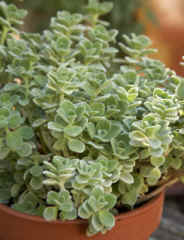
|
Oregano
Yes, i know it's listed on the ASPCA list as toxic to dogs.
But I also saw dozens
of bits of research and veterinarian comments that state that it's completely
safe in small doses. You and your vet can decide. Choose wisely.
I grow it as a culinary herb for myself anyway. It's invaluable
in my Italian and Greek culinary endeavors. There are several
different types. It is very pretty, fragrant and perennial.
I feed it to my dog either as an ingredient in her home cooked food, or sprinkled on it.
Oregano is high in antioxidants and flavonoids and is reported to be
antimicrobial. This herb has been used to help with digestive problems,
diarrhea, and gas. |
|
|
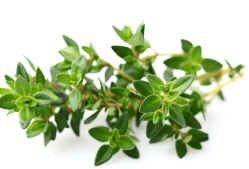 |
Thyme
Thyme contains Vitamins K, iron, calcium, manganese, fiber and
phytochemicals.
There are several varieties of thyme. I grow the ground-hugging variety, and I
grow the larger plants in elevated raised planters with other culinary herbs.
My
favorite is lemon thyme. It can be made into teas, and is popular in cooking
poultry, fish, soups, stews and veggie dishes.
Itís a good herb for the skin, respiratory system
and brain function. It is usually used dry and sprinkled onto your dog's food.
Thyme is a hardy perennial.
|
|
Fruits and Veggies To Grow For Your Dog
|
Growing dwarf
versions of fruit trees and shrubs is easy. Especially if you
grow them in pots or in elevated raised garden beds. This makes
them easy to tend and pots are portableand moveable. You can
grow small trees with fruit as big as standard fruit trees. If
you have room in your unheated garage or basement, the non-hardy
and tropical varieties can over-winter indoors. Plant them in
big pots, and be sure not to make them heavier than you can
easily drag, wheel or carry indoors. You and your dog can enjoy
dried or fresh fruit together, fresh or right off the plant. Put
the trees back outside in spring. I do this with my lemon, lime
and fig trees, and it works beautifully.
Many Fruits and veggies for a dog's
medicinal garden can be dried in a dehydrator or slow oven or frozen in slices.
Don't add sugar or spices, except for those listed above.
These can be added to a diet fresh from a
plant, frozen and thawed, or dried without sugar. Spices from the above list can
be added. My dog loves
dried fruit. She recently got a taste of dried kiwi and dried watermelon slices,
and they're now near the top of her favorites list.
Cranberries - My dog's
all-time favorite dried
fruit, and she's been given this treat dried or jellied, or a small handful of
dried mixed into her food for more than a decade. Cranberries are good for
kidney health. I give her a few slices of jellied cranberry with no additives in
her food every now and then.
Dried Strawberry, watermelon, blackberries, raspberries, figs and dates.
Mango
Apple
Papaya
Pineapple
Vegetables
Beets - My dog loves sweet (non-fermented)
cooked beets. Sliced or diced is convenient to add to her meals.
If I buy it in a can, I get the beet juice, which is very good
for your health. "And it's tasty, too!"
Potatoes - Mashed and mixed into a meal.
Spinach - My dog likes it cooked and part of any meal.
Kale - I sneak it into her food because
it's good for her, but she always picks it out unless it has condiments added to it. I chop it finely,
and mix it raw into her food. She likes it cooked best, mixed into anything. I'll occasionally give
her roasted and unsalted kale, sprayed with olive oil.
Sweet potatoes - Probably every dog's
favorite. If you can grow it, you can save space by planting them in those
potato
"grow bags" that have a flap in the front, so that you save space and
have easy access. They are easy to grow.
Pumpkin
You can grow very pretty dwarf, non-vining
pumpkin plants in big pots and have enough for you and your dog, and they're
very ornamental when in bush form. I grow white mini pumpkins called
"Casperita".
Pumpkin and it's seeds are a natural source of
unsaturated fatty acids, carbohydrates, amino acids, vitamins C, D, E, K and
most B Vitamins.
It's a natural dewormer, and it soothes itchy skin. I scoop out raw seeds, and
use 1 tsp. of the ground seeds sprinkled into her food. I also include it in her
special meatloaf mix.
I cook pureed pumpkin into my dog's weekly batches of crockpot meals, and
she loves it as much as sweet potatoes. Pumpkin seeds are sprinkled on to her
food now and then. If I don't eat all of them. I grew mini pumpkins, and we both
feasted on the sweeter little pumpkins and the roasted seeds, after the little
punkins are done decorating my autumn tables.
I grind the cooked seeds for her and sprinkle it on her food. Or I get organic,
unsalted
shelled seeds when they're on sale at Whole Foods.
Enjoy creating a beautiful herbal and
ornamental garden for your dog, and combine it with a culinary/medicinal garden
for yourself. It's good for your health, wellness and serenity, and it smells
wonderful, too.
Article ©2022 Mary's Bloomers
All rights reserved.
Articles may not be reproduced wholly, or
in part, without written consent.
|
Design,
graphics, articles and photos ©2008+ marysbloomers.comô
All rights reserved.
|
